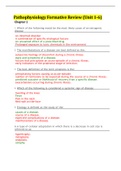Exam (elaborations)
PSY 324 EXAM 1 UPDATED EXAM WITH MOST TESTED QUESTIONS AND ANSWERS | GRADED A+ | ASSURED SUCCESS WITH DETAILED RATIONALES
- Course
- Institution
PSY 324 EXAM 1 UPDATED EXAM WITH MOST TESTED QUESTIONS AND ANSWERS | GRADED A+ | ASSURED SUCCESS WITH DETAILED RATIONALES
[Show more]





